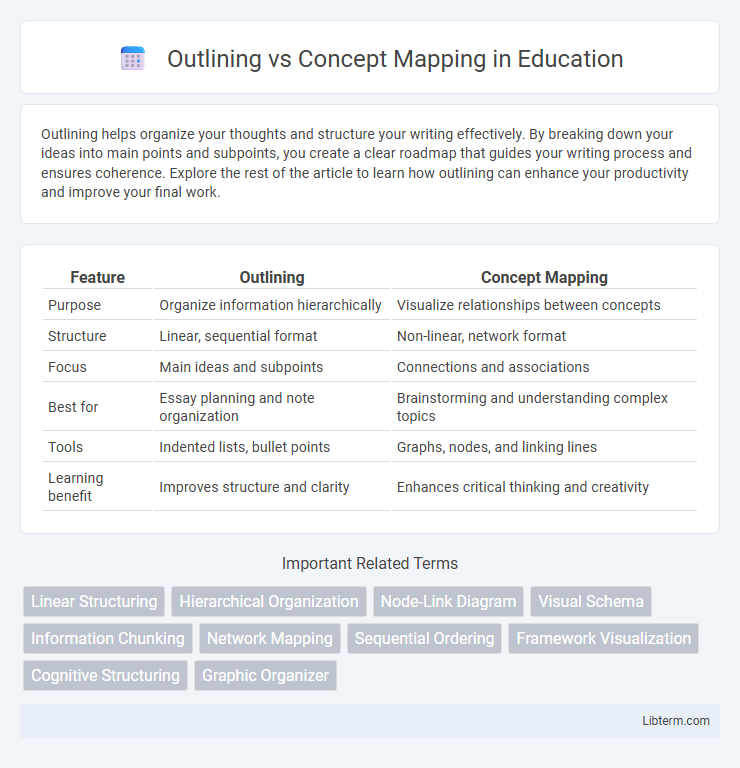Outlining helps organize your thoughts and structure your writing effectively. By breaking down your ideas into main points and subpoints, you create a clear roadmap that guides your writing process and ensures coherence. Explore the rest of the article to learn how outlining can enhance your productivity and improve your final work.
Table of Comparison
| Feature | Outlining | Concept Mapping |
|---|---|---|
| Purpose | Organize information hierarchically | Visualize relationships between concepts |
| Structure | Linear, sequential format | Non-linear, network format |
| Focus | Main ideas and subpoints | Connections and associations |
| Best for | Essay planning and note organization | Brainstorming and understanding complex topics |
| Tools | Indented lists, bullet points | Graphs, nodes, and linking lines |
| Learning benefit | Improves structure and clarity | Enhances critical thinking and creativity |
Introduction to Outlining and Concept Mapping
Outlining organizes ideas hierarchically using headings and subheadings to create a linear structure ideal for sequential thinking and detailed planning. Concept mapping visually represents relationships between concepts through nodes and connecting lines, facilitating nonlinear thinking and enhancing creativity. Both techniques improve knowledge organization but serve different cognitive approaches for brainstorming and information synthesis.
Defining Outlining: Structure and Purpose
Outlining organizes information hierarchically, using headings and subheadings to establish clear relationships between main topics and supporting details. Its primary purpose is to provide a structured framework that guides both the creation and comprehension of complex content. By emphasizing logical progression, outlining enhances clarity and facilitates efficient information retrieval.
Understanding Concept Mapping: Overview and Key Features
Concept mapping is a visual representation technique that organizes and connects ideas through nodes and labeled links, facilitating a deeper understanding of relationships between concepts. Unlike linear outlining, concept maps allow for non-hierarchical structures, enabling learners to see complex interconnections and hierarchical relationships simultaneously. Key features include the use of cross-links to show relationships between different domains, inclusion of examples for clarity, and a focus on integrating new knowledge into an existing conceptual framework.
Key Differences Between Outlining and Concept Mapping
Outlining structures information hierarchically using headings and subheadings to organize linear thoughts, while concept mapping visually represents relationships between ideas in a non-linear format. Outlines emphasize sequential order and clarity in topics, whereas concept maps highlight connections and interactions among concepts with nodes and linking phrases. The key difference lies in outlining's focus on hierarchical, text-based organization versus concept mapping's graphical, relational approach to knowledge representation.
Advantages of Outlining in Organizing Information
Outlining excels in organizing information by providing a clear, hierarchical structure that simplifies complex content into manageable sections and subpoints, enhancing clarity and logical flow. It facilitates efficient review and revision by allowing easy identification of main ideas and supporting details. Outlines also improve productivity by streamlining the writing process and aiding in timely completion of projects.
Benefits of Concept Mapping for Visual Learners
Concept mapping enhances comprehension for visual learners by organizing information spatially, allowing for better recognition of relationships among concepts. This method supports memory retention and critical thinking through visual cues like colors and shapes, making complex information more accessible. Unlike outlining, concept maps provide a flexible and holistic overview that caters to learners who benefit from graphical representation of knowledge.
Choosing the Right Tool: Outlining vs Concept Mapping
Choosing the right tool between outlining and concept mapping depends on the nature of the information and the desired outcome. Outlining excels in organizing hierarchical, linear data with clear relationships and sequential order, making it ideal for structured writing or project planning. Concept mapping supports visual thinking by illustrating complex connections and non-linear relationships, enhancing creativity and deeper understanding in brainstorming or problem-solving sessions.
Practical Applications in Education and Business
Outlining structures information hierarchically, enhancing clarity in writing, project planning, and curriculum design by organizing ideas linearly, which is particularly useful for preparing reports and essays in both educational and business contexts. Concept mapping visually represents relationships between concepts, fostering deeper understanding, brainstorming, and problem-solving, making it ideal for collaborative projects, knowledge retention, and strategic planning sessions. Educators leverage outlining for lesson plans and assessments, while businesses apply concept mapping in innovation workshops and complex decision-making processes.
Tips for Effective Outlining and Concept Mapping
Effective outlining involves using hierarchical structures and consistent numbering to organize main ideas and supporting details clearly. Concept mapping benefits from visually linking related concepts with labeled connectors to illustrate relationships and enhance memory retention. Both techniques improve information processing by promoting clarity and active engagement with the material.
Conclusion: Selecting the Optimal Approach
Selecting the optimal approach between outlining and concept mapping depends on the task complexity and individual cognitive style, with outlining being ideal for linear, structured content and concept mapping excelling in visualizing relationships among ideas. Outlines enhance clarity and organization for essays or reports, while concept maps foster creativity and deeper understanding in brainstorming or problem-solving scenarios. Evaluating the specific needs of the project and personal workflow preferences ensures effective knowledge representation and improved information retention.
Outlining Infographic

 libterm.com
libterm.com